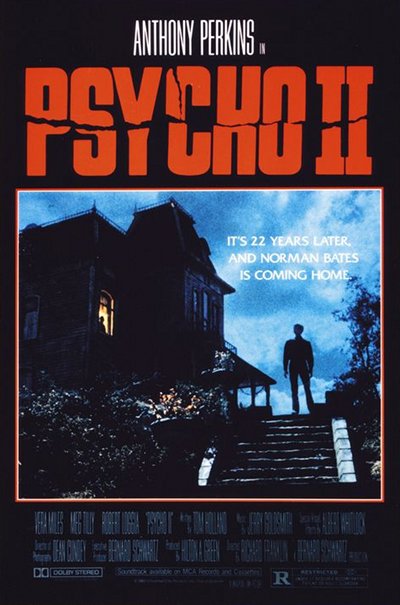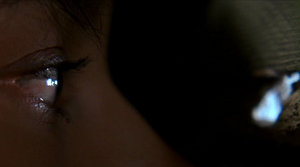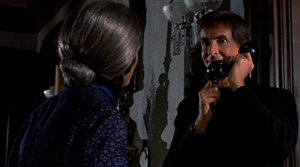
Throughout his half a century career, Alfred Hitchcock had always resisted directing a sequel. He had become of the most respected filmmakers in cinema history and had been responsible for countless classics that had covered every conceivable genre, varying from the psychological (Vertigo) and the voyeuristic (Rear Window) to the action packed (North By Northwest) and the sadistic (Frenzy). But none had made the cultural impact that Psycho had when it was first unleashed in 1960. Despite disgusting many critics and confusing others, the film eventually gained momentum and was later considered by many to be his ultimate masterpiece. Psycho would also play a part in inspiring the slasher films of the seventies, particularly Black Christmas and Halloween, which themselves would help usher in the genre’s heyday of the early eighties.
 Having spent the last two decades incarcerated in a mental institution, Norman Bates (Anthony Perkins) is finally released back into society. But Lila Loomis (Vera Miles), whose own sister had fallen victim to his murder spree, protests against the decision, producing a petition that had been signed by over seven hundred people, including families of some of those he had slain. Returning to his home, his sympathetic doctor, Bill Raymond (Robert Loggia), tries to reassure him that the past is behind him and introduces him to Warren Toomey (Dennis Franz), who had been running the Bates Motel in his absence. To help rehabilitate him back into the real world, the courts have secured a position for Norman as an assistant cook at a nearby diner, where he meets a beautiful-yet-troubled young woman called Mary (Meg Tilly).
Having spent the last two decades incarcerated in a mental institution, Norman Bates (Anthony Perkins) is finally released back into society. But Lila Loomis (Vera Miles), whose own sister had fallen victim to his murder spree, protests against the decision, producing a petition that had been signed by over seven hundred people, including families of some of those he had slain. Returning to his home, his sympathetic doctor, Bill Raymond (Robert Loggia), tries to reassure him that the past is behind him and introduces him to Warren Toomey (Dennis Franz), who had been running the Bates Motel in his absence. To help rehabilitate him back into the real world, the courts have secured a position for Norman as an assistant cook at a nearby diner, where he meets a beautiful-yet-troubled young woman called Mary (Meg Tilly).
As their shift comes to an end, Mary is left stranded after falling out with her boyfriend and so Norman offers for her to stay at his motel. But upon his return home, he discovers that Warren has been using the establishment for less respectable means and fires him, before suggesting that she should stay in his house instead. But whilst at work the following day, a note from ‘mother’ appears and Norman believes that it is Warren trying to get revenge, who has become abusive towards him in the diner. Soon afterwards, as Warren is gathering his belongings from the motel, he is murdered by a mysterious figure. The house seems to be full of strange sounds, which eventually lure Norman up into the attic, where he accidentally locks himself.
 A teenage couple sneak into the house to make out in the cellar, but the figure makes another appearance, brutally stabbing the boy, which allows the girl enough time to escape. She returns with the sheriff (Hugh Gillin), shortly after Mary finds Norman trapped in the attic. The sheriff arrives and searches the cellar for the body of the boy but finds no evidence. Norman begins to feel that he is losing a grip on his sanity and begins to suspect himself of being the killer, but Mary tries to reassure him that he is cured and was unable to have attacked the boy. Searching the house, they find bloodied rags in the bathroom, but as Mary explores elsewhere she comes face to face with Lila, who is really her mother and has sent her into the house to spy on him. Lila’s motives soon become clear, that he intends on driving Norman insane once again so he will be committed for good.
A teenage couple sneak into the house to make out in the cellar, but the figure makes another appearance, brutally stabbing the boy, which allows the girl enough time to escape. She returns with the sheriff (Hugh Gillin), shortly after Mary finds Norman trapped in the attic. The sheriff arrives and searches the cellar for the body of the boy but finds no evidence. Norman begins to feel that he is losing a grip on his sanity and begins to suspect himself of being the killer, but Mary tries to reassure him that he is cured and was unable to have attacked the boy. Searching the house, they find bloodied rags in the bathroom, but as Mary explores elsewhere she comes face to face with Lila, who is really her mother and has sent her into the house to spy on him. Lila’s motives soon become clear, that he intends on driving Norman insane once again so he will be committed for good.
One aspect that lends the film some authenticity is that Psycho was not only set twenty-two years after Hitchcock’s classic but was also produced in 1982, over two decades after the release of the original movie (released in 1960). When news of a sequel was first announced, critics and fans were understandably reluctant to accept a new film. Very few filmmakers had been able to match Hitchcock for not only his style but also storytelling, and so a sequel was guaranteed to disappoint. But, whilst director Richard Franklin lacked the experience of recognition of his predecessor, he managed to exceed all expectations by delivering a movie that not only managed to create a certain degree of suspense and tension but also believable and sympathetic characters.
 Tom Holland, who would later gain acclaim as a director in his own right with the cult classics Fright Night and Child’s Play, wrote a screenplay that wisely avoided unnecessary gore or nudity and instead focused on the relationship between the central characters, particularly Norman and Mary. Perkins once again dominated as the complex protagonist/antagonist, who manages to demand a certain amount of sympathy as the almost-vulnerable Norman. Tilly also gives an impressive turn, lending a certain human aspect to the story that allows Perkins to flesh his character out even more. Miles makes a return to the role she had played in the original, although this time she is bitter and vengeful due to her sister (who perished in the iconic shower scene) being murdered years earlier. If Psycho 2 has a flaw it is that it is not Psycho. But it is a worthy successor and continues Norman’s story in a way in which Hitchcock would have been proud. A shame the same could not have been said for the sequel that followed.
Tom Holland, who would later gain acclaim as a director in his own right with the cult classics Fright Night and Child’s Play, wrote a screenplay that wisely avoided unnecessary gore or nudity and instead focused on the relationship between the central characters, particularly Norman and Mary. Perkins once again dominated as the complex protagonist/antagonist, who manages to demand a certain amount of sympathy as the almost-vulnerable Norman. Tilly also gives an impressive turn, lending a certain human aspect to the story that allows Perkins to flesh his character out even more. Miles makes a return to the role she had played in the original, although this time she is bitter and vengeful due to her sister (who perished in the iconic shower scene) being murdered years earlier. If Psycho 2 has a flaw it is that it is not Psycho. But it is a worthy successor and continues Norman’s story in a way in which Hitchcock would have been proud. A shame the same could not have been said for the sequel that followed.

4 Responses to Psycho 2 (1983) Review